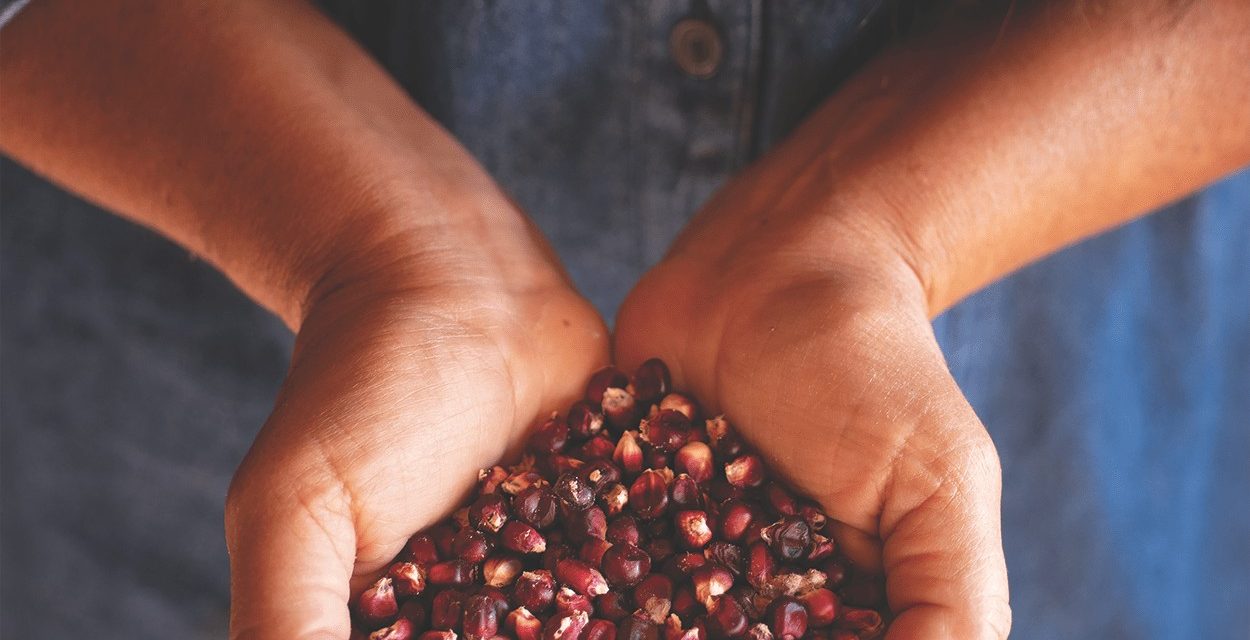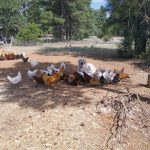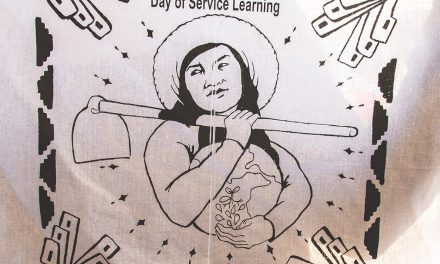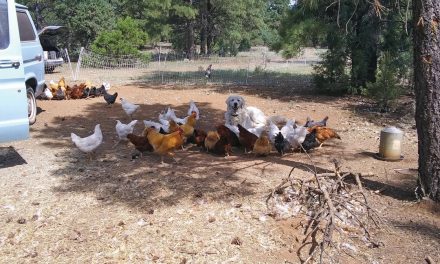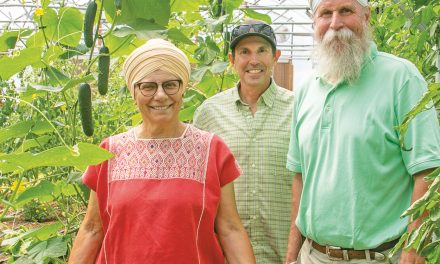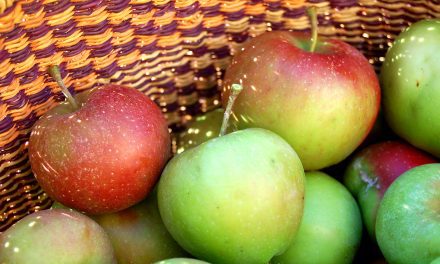Saving the Roots of Native Truth
By Briana Olson · Photos by Douglas Merriam

When I leave sculptor, seed saver, and permaculturist Roxanne Swentzell’s home in Santa Clara Pueblo, my hands are so full that it’s hard to open the car door. I’m trying to eat ripe figs picked from the tree that winds in front of the windows at the entryway and a cluster of sweet green grapes from the arbor that shades the patio while I clutch a jar of freshly canned applesauce made from fruit grown in her small orchard. None of these fruits would have been allowed during the Pueblo Food Experience (PFE) Swentzell undertook five years ago—participants limited themselves to eating foods that would have been available to their Pueblo tribes prior to the arrival of Spanish colonizers, and figs and apples, as well as most varieties of domestic grape, came to the Americas on European ships—but everything grown on her one-eighth-acre plot supports the broader mission behind the Pueblo Food Experience: food sovereignty, or, in Swentzell’s words, “taking control of your food again.”
“Let’s make it a food revolution,” she says near the start of Return: Reclaiming Native Foodways for Health and Spirit. A short documentary by Karen Cantor, Return follows Swentzell and five other Native American women leading efforts to revitalize tradition, and health, in their tribal communities. Speaking of what she and other participants in the Pueblo Food Experience learned about Pueblo cultivation and the generational adaptations of crops to the Southwestern landscape and climate, Swentzell asserts, “We are the descendants of the people who figured this out.” This is no insignificant fact—and not just because one of those crops, corn, has become the biggest driver in the agricultural economy of the United States. By reclaiming traditions, these community leaders are reclaiming the value of Indigenous knowledge. As Tlingit nutritionist Desiree Jackson observes later in the film, traditional Native foods were associated with not having money, and thus a source of shame, “because they were something you harvested.” This might have a parallel to the broader twentieth-century shift away from small-scale farming, but for tribes, giving up traditions was not a choice; it resulted from forced relocation and multi-prong government strategies to enforce cultural assimilation. “Our lands were taken,” says Oglala Sioux nutritionist Kibbe Conti. “Our people were confined to reservations and our health began to suffer.” For Conti, as for the other women featured in the film, it’s clear that going back—looking to the wisdom of grandmothers and ancestors—is the way forward.

“All the crops have stories,” Swentzell tells me. “They help keep the stories alive.” We’re sitting at her table, sipping the herbal tea she offered the moment I set foot inside, and I’ve asked her about the connection between cultural history and the way humans eat. She picks up a dried cob of blue-black corn and talks about how different the earlier varieties of corn were. Their kernels were spaced farther apart, she explains, and the plants looked more like grass. Culture is a byproduct of food, she says, so reviving the connection between cultural history and food is a byproduct of bringing it back home. The crops, Swentzell says, “are the gifts of my ancestors. It’s my responsibility to carry them on.” Seeds passed down through generations carry a people’s history, whereas “Walmart grapes don’t have any meaning but what the price is.”
The Pueblo Food Experience, like the other community work described in Return, was initially inspired by health issues. Processed food has negatively impacted all Americans, leading to a widespread increase in obesity, but it seems to have had a worse impact on Native Americans, who are twice as likely as white Americans to suffer from diabetes. And the fourteen participants in the Pueblo Food Experience achieved dramatic improvements in health—not simply, in Swentzell’s view, because they’d switched to a natural, low-fat diet, but because of how these pre-contact, indigenous crops fit the people who had evolved along with them. Crops adapt to climate and soil over time, and Swentzell believes that people do, too; she describes the relationship between Pueblo peoples and crops as “a mutual coexistence for thousands of years.” In contrast, sugar, wheat, and oil—three ingredients that, she half-jokes, are found in almost every product you can buy in a store—were unknown to Indigenous peoples prior to colonization.
The food list in The Pueblo Food Experience Cookbook includes animals, like rabbit, buffalo, and fish, that are low in fat, and gathered foods, like purslane and dandelion, that are low in sugar content, so participants had to develop strategies to resist grabbing candy bars and bags of chips from the convenience store shelves. For most, Swentzell says, sugar was the greatest challenge. As with any diet, they found that preparation was key: carrying snacks made from foods on the list (Swentzell swore by a trail mix of currants, pumpkin seeds, and piñons); using slow cookers to avoid relying on fast food for dinner after a busy day at work. The group also met for weekly potlucks, where they exchanged strategies—and stories.
“Salt was like gold,” Swentzell says, recounting the group’s poignant journey to the Estancia salt flats. On the way there, she says, they shared stories about the salt mother who’d been lost to the native peoples of New Mexico. After colonization, Natives forced into slavery were made to mine the flats, truckloads of the salt their cultures had honored were driven south and sold in what is now Mexico, and by the time the Spanish abandoned the salt flats, they’d come to represent sorrow and loss for the Pueblos. Reflecting on this, I recall the words of another woman featured in Return. “A Muckleshoot person without a plate of salmon,” says community educator Valerie Segrest, “doesn’t exist.” While watching the film, I found myself questioning this statement. What if there are no salmon left, I wondered; what happens to the Muckleshoot when all the salmon is too tainted and toxic to eat? But that, of course, is part of the point. A people whose identity is bound to the crops it cultivates and the species it hunts is bound to protect the land and waters those species need to thrive. For a farming people, that responsibility extends to the seeds themselves. “Corn,” says Swentzell, “is a person just like everybody else in the tribe.”

Behind her home, a small unlighted cellar contains troves of Puebloan history. Unassuming shelves cradle jars of the corn, beans, and squash seeds honored over many generations. The seed bank itself dates to 1982, when Swentzell started collecting seeds from “the original plants of our people here.” Her first seeds came from the ashes of a vandalized seed bank that burned down in Ohkay Owingeh. Seeds have a shelf life, so she works to keep them viable by growing out different varieties of ancestral crops. At one point, she laughs about trying to save “the last squash” and how heartbreaking it can be to watch people coming home from Walmart with their groceries. “It’s lonely,” she says of seedkeeping. “I offer to share and no one comes!” That hasn’t kept her from it, though. Over the years, she’s developed her own variety of chile, and through many seasons of selection has cultivated a sweet Hopi Supi corn. A few of its reddish cobs hang outside the seedbank. “The birds are eating it,” she says. This year, she raised half an acre of corn for chicos from this same seed, along with a good crop of squash, in a field owned by the Española Farmers Market.
It’s here, at the seed, that the distinction between food security and food sovereignty becomes clear. The global grassroots alliance of peasant farmers, La Via Campesina, introduced the term food sovereignty at the 1996 World Food Summit, and while both concepts have evolved since then, the concept of food security remains centered on “enough”: enough food, enough nutrition, enough culturally appropriate ingredients. Food sovereignty, in contrast, is about control. At the moment, three corporations control about fifty percent of the world’s seed. Over the past century, three quarters of earth’s seed diversity has been lost. Proponents of industrial agriculture and commercial plant breeding argue that their methods—increasing yield and resistance to pests and disease—are essential to ensuring food security, but food sovereignty activists argue that meaningful food security depends on local control of food production. In October, La Via Campesina called on family farmers and communities around the world to join their global seed campaign by adopting a seed—a challenge Swentzell, with her Supi corn, has already taken on.
“Food is so disconnected from us,” she says when I ask how the locavore movement connects to all of this. For the majority of Americans, food production “is just some tractor in Illinois, so the gap is huge.” She sees eating locally as one step toward food sovereignty. Maybe first you start shopping at the co-op, the local store; next, you buy at the farmers market, so “you actually look at a farmer before you buy it”; then maybe you plant seeds in a community garden, harvest carrots, wash them yourself, “taste them right out of the ground.”
Those are all good steps, Swentzell says, “but it can go all the way to being sacred again.” “When it comes all the way home,” she says—when you raise a chicken from birth to death, “when you remember a funny story about how it tripped over the water bucket . . . when you have to wait for the tomatoes to ripen—then you don’t waste any of it.” I think of her chickens, penned in with the newly purchased goats who are still learning to eat the weeds that they’ll turn into fertilizer for her ancestral corn and squash. “That’s what we’re missing, is the relationship; you appreciate [food you’ve raised yourself] in a way you can’t appreciate a cereal box.” And that’s the cultural element, she says; that’s when “you realize why we danced for rain. To me, that’s the final food sovereignty.” She pauses, then, and adds, “And you understand why that gap is there; no one wants to remember it died, no one wants to kill their favorite pig. But maybe it’s time we do remember someone died for it.”
These days, Swentzell does not practice a pure form of the pre-contact diet. She sometimes eats things like chicken and grapes and domesticated strawberries that don’t figure on the PFE food list, but she grows and gathers as much as she can. She practices a tenet of permaculture that may well have been appropriated from Indigenous peoples: Produce No Waste. Every spring, she participates in the Ówingeh Táh Pueblos y Semillas Gathering and Seed Exchange. “It’s the only thing,” she says, “that honors everyone who lives in this valley.” I think, by everyone, she means not just every ethnic group, but every crop. The corn mothers as well as the farmers, the living as well as the ancestors. And no matter who you are or where you come from, Swentzell believes you can raise your own food and find your way to your own agricultural roots. Don’t have enough land? “Tear out your lawn,” she suggests. “Instead of fancy ornamentals, grow fruit trees.”

Briana Olson
Briana Olson is a writer and the editor of edible New Mexico and The Bite. She lives in Albuquerque.

